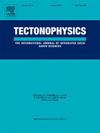Seismogenic independence of earthquake doublet: Insights from the 2023 Kahramanmaraş, Türkiye earthquake sequence
IF 2.6
3区 地球科学
Q2 GEOCHEMISTRY & GEOPHYSICS
引用次数: 0
Abstract
The interplay between large earthquake doublets often involves a triggering mechanism, yet the specifics of their interaction during the seismogenic process remain poorly understood. Here, we examine the seismogenic relationship using the 2023 Kahramanmaraş, Türkiye earthquake doublet. By analyzing repeating earthquakes (REs) prior to the two 2023 events, we estimated the pre-seismic deep slip rates along the East Anatolian Fault (EAF) and assessed fault movement. Utilizing two distinct earthquake relocation techniques, we identified REs and improved the accuracy of their locations. Our findings reveal a higher deep slip rate of approximately 20 mm/year at the Maras triple junction (MTJ) of the EAF, contrasting with previous estimates based on surface fracture observations. The dense clustering of REs at the MTJ suggests that the seismogenic zone of the first event was weakly coupled and may have undergone accelerated creep before the doublet. Conversely, the seismogenic zone of the second event showed minimal seismic activity and a lack of REs. Integrating these results with regional tectonic data, we suggest that the seismogenic environments of the doublet are markedly different, indicating that the seismogenic processes of the two events are largely independent.
地震双重波的发震独立性:来自2023年kahramanmaraku, trkiye地震序列的见解
大地震偶极体之间的相互作用通常涉及一种触发机制,但它们在发震过程中相互作用的细节仍然知之甚少。在这里,我们使用2023年kahramanmaraki, trkiye地震双重波来研究发震关系。通过分析2023年两次地震前的重复地震(REs),我们估计了东安纳托利亚断层(EAF)的震前深滑动率,并评估了断层运动。利用两种不同的地震定位技术,我们确定了REs并提高了其位置的准确性。我们的研究结果表明,在EAF的Maras三重交界处(MTJ),与之前基于地表断裂观察的估计相比,深层滑移率更高,约为20毫米/年。在MTJ密集聚集的REs表明,第一次事件的发震带是弱耦合的,可能在双峰之前经历了加速蠕变。与此相反,第二次活动的孕震带表现为地震活动最少,且缺乏res。结合区域构造资料,我们认为两次活动的孕震环境明显不同,表明两次活动的孕震过程在很大程度上是独立的。
本文章由计算机程序翻译,如有差异,请以英文原文为准。
求助全文
约1分钟内获得全文
求助全文
来源期刊

Tectonophysics
地学-地球化学与地球物理
CiteScore
4.90
自引率
6.90%
发文量
300
审稿时长
6 months
期刊介绍:
The prime focus of Tectonophysics will be high-impact original research and reviews in the fields of kinematics, structure, composition, and dynamics of the solid arth at all scales. Tectonophysics particularly encourages submission of papers based on the integration of a multitude of geophysical, geological, geochemical, geodynamic, and geotectonic methods
 求助内容:
求助内容: 应助结果提醒方式:
应助结果提醒方式:


